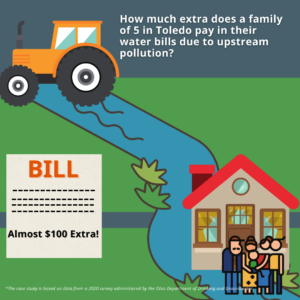
Ohioans across the state are struggling to afford their water and sewer bills. A first-of-its-kind case study finds that water bills are pushed even higher for communities that pull their drinking water from Lake Erie due to harmful algal blooms caused by upstream agricultural pollution. And the costs are not insignificant. An analysis by the Alliance for the Great Lakes found that a family of five in Toledo is paying roughly an additional $100/year in their water bill because of this pollution problem. The case study illuminates the fact that downstream water users are paying a real cost for managing a pollution problem they did not create, compounding water affordability issues faced by many Ohioans.
Harmful Algal Blooms Threaten Drinking Water
Each summer, western Lake Erie experiences massive algal blooms which can produce harmful toxins that threaten drinking water supplies. These blooms are fueled by excess nutrients flowing off upstream agricultural lands into the lake.
The harmful algal blooms (HABs) in western Lake Erie can produce harmful cyanotoxins, a common one being microcystin. These toxins are a serious threat to human and animal health. Microcystin is a potent liver toxin and a possible human carcinogen. Cyanotoxins can also kill livestock and pets that drink affected waters.
Almost eight years ago, toxins from an algal bloom got into the drinking water systems of Toledo, Ohio. On August 2nd, 2014, more than half a million Toledo-area residents were ordered not to drink or even touch their water. The order lasted for nearly three days. A few weeks later, residents of Pelee Island, Ontario faced a similar crisis lasting nearly two weeks.
Pollution Burden Shouldered by Downstream Water Users
To ensure drinking water safety, drinking water facilities that draw water from Lake Erie have put into place additional monitoring and treatment, which can cost millions of dollars. This is a very real financial burden for drinking water facilities, which gets passed on to ratepayers.
These additional costs – which are critical to ensure safe drinking water – add up. The Alliance’s analysis found the additional annual average per-capita cost for HAB-related monitoring and treatment for Ohio residents who get their drinking water from Lake Erie is $10.48. For Toledo-area residents, the additional cost jumps to $18.76 per year, which translates to almost $100 extra per year on a water bill for a family of five. The case study is based on data from a 2020 survey administered by the Ohio Department of Drinking and Groundwater.
Downstream ratepayers, many of whom are already struggling to pay their water bills, should not have to shoulder the financial burden of addressing this pollution problem. And the longer this pollution problem continues, the costs will only increase as the water quality in western Lake Erie continues to degrade.
Improved Data, Transparency, and Accountability Needed
The case study identified three lessons learned from the analysis. They are:
- Downstream Water Users Bear the Burden of Upstream Polluters: Downstream ratepayers are paying a real cost for managing a pollution problem they did not create. And, it is exacerbating existing water affordability issues. Ohio needs a statewide conversation about who is responsible for this financial burden. The state of Ohio must give downstream stakeholders a meaningful seat at the table in policy discussions on stopping agricultural runoff pollution.
- Ongoing Data Needed: The Ohio Department of Drinking and Groundwater should repeat this survey every three years. However public water facilities should collect cost information related to HABs on an annual basis. The data in this report is from 2020, which was a relatively small algal bloom year in western Lake Erie. Many costs incurred by water treatment facilities are variable depending on the bloom size and toxicity. Repeating the study will provide more accurate information to ratepayers, elected officials, and government agencies managing this pollution problem.
- Transparent & Accessible Data Needed: The information in this case study was received only after learning Ohio Environmental Protection Agency conducted the cost survey and the Alliance for the Great Lakes requested the results from the agency through a public records request. It is unacceptable that this is not easy to find and understand public information. Ratepayers should be able to easily access this information and have a right to know the impact upstream pollution has on their water bills.
